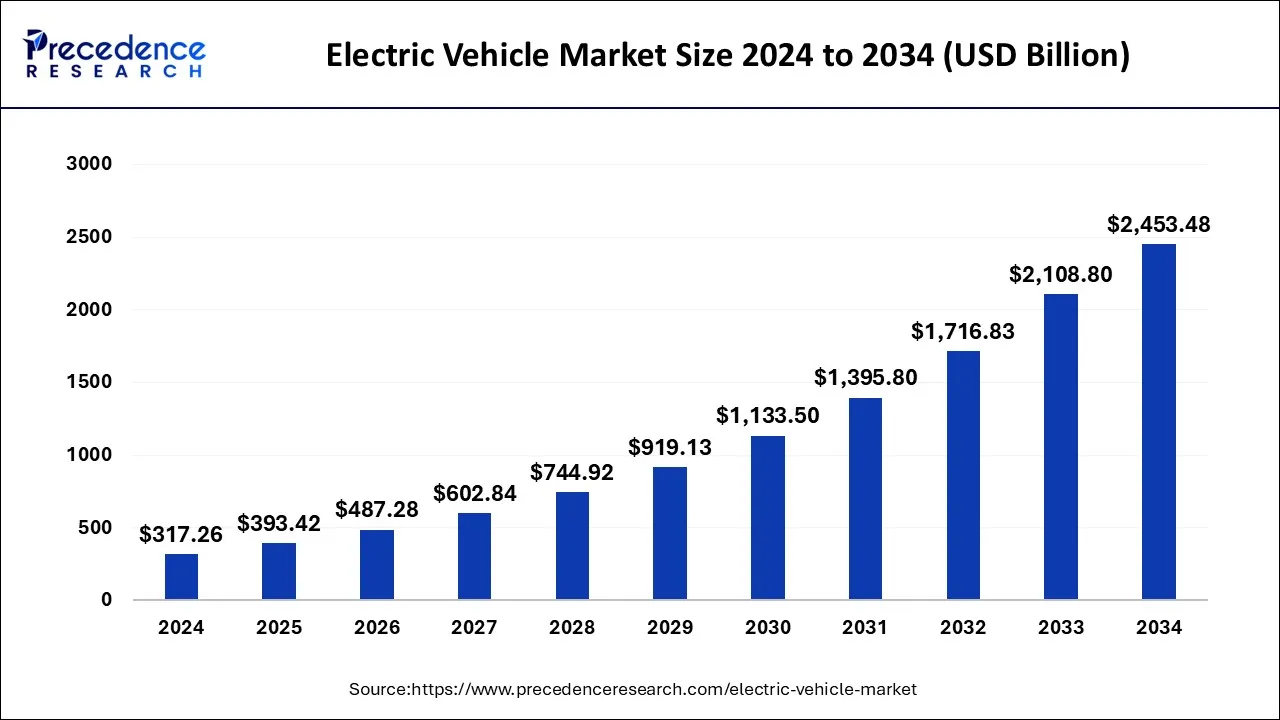EV Market Growth Projected to Hit $2,453.48 Billion by 2034

- Asia Pacific held the largest EV market share in 2024 at 42.14%, valued at USD 107.68 billion.
- Battery electric vehicles (BEVs) accounted for 67.7% of total EV revenue in 2024.
- Passenger cars represented 62.4% of EV market revenue in 2024.
- Europe targets a 40% greenhouse gas reduction by 2040 and aims for net zero by 2050.
- Norway and Iceland registered 86% and 64% of new electric cars in 2021, respectively.
- The hybrid EV market is forecasted to grow from USD 77,581.7 million in 2021 to USD 301.67 billion by 2030.
- The plug-in hybrid EV market is expected to reach USD 385,617 million between 2025 and 2034.
- The passenger car EV segment is projected to grow from USD 127,394 million in 2021 to USD 598,735 million by 2030.
- The commercial EV sector was valued at USD 47,351.9 million in 2024.
- The luxury EV market is on track to expand from USD 104,380 million in 2021 to USD 441,273 million by 2030
Electric Vehicle (EV) Market Overview
The electric vehicle (EV) market is expanding rapidly as the automotive industry transitions toward sustainable and eco-friendly transportation solutions. Powered by electricity rather than conventional internal combustion engines, EVs have gained widespread popularity due to their environmental benefits, reduced operating costs, and advancements in battery technology. Governments across the globe are enforcing stringent emissions regulations, providing incentives, and investing in charging infrastructure to accelerate EV adoption. Meanwhile, automakers continue to innovate, introducing new models with enhanced range, performance, and affordability, making electric vehicles increasingly accessible to consumers. As a result, the EV market is on track for significant growth in the coming years.
Market Drivers
Several key factors are driving the growth of the EV market. Increasing environmental awareness and concerns over carbon emissions are pushing governments and consumers toward cleaner transportation alternatives. Stringent regulations on vehicle emissions and fuel efficiency standards are compelling automakers to accelerate their electrification efforts. The declining cost of lithium-ion batteries has made EVs more cost-effective, narrowing the price gap between electric and conventional vehicles. Additionally, advancements in fast-charging technology and the expansion of charging networks are reducing range anxiety, making EVs more practical for everyday use. The rising adoption of smart and connected vehicle technologies further enhances the appeal of electric vehicles, improving overall driving experience and efficiency.
Opportunities in the Market
The electric vehicle market presents numerous opportunities for growth and innovation. The transition to EVs is creating a surge in demand for battery technology, opening doors for advancements in solid-state batteries and alternative energy storage solutions. The development of ultra-fast charging stations and wireless charging technologies offers significant potential for improving EV convenience. Emerging markets, particularly in Asia, Latin America, and Africa, present a vast opportunity for expansion as governments and consumers recognize the benefits of electrification. Additionally, the rise of autonomous and shared mobility solutions is expected to drive EV adoption further, particularly in urban areas with strong infrastructure support.
Challenges Facing the Market
Despite its promising growth, the EV market faces several challenges. The high initial cost of electric vehicles remains a barrier for many consumers, especially in developing economies. Although battery prices are declining, the affordability of EVs compared to gasoline-powered vehicles is still a concern. Charging infrastructure development is another major challenge, as many regions still lack a widespread and reliable charging network. The limited availability of raw materials such as lithium, cobalt, and nickel for battery production poses supply chain risks and cost fluctuations. Additionally, concerns about battery life, recycling, and disposal present environmental and regulatory hurdles that need to be addressed to ensure long-term sustainability.
Regional Insights
The EV market is expanding across different regions at varying paces. China leads the global EV industry, supported by strong government policies, subsidies, and a well-established manufacturing ecosystem. Europe is also a major player, with stringent emissions regulations and aggressive electrification targets driving EV adoption. Countries such as Germany, Norway, and the Netherlands are at the forefront of this transition. North America, particularly the United States, is witnessing steady growth, driven by federal and state incentives, increasing consumer interest, and investments in charging infrastructure. Meanwhile, developing regions in Latin America, Africa, and Southeast Asia are gradually entering the EV market, with growing investments in sustainable transportation and infrastructure improvements.
